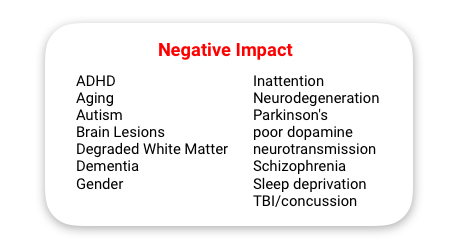Reaction time has been used since the mid-1800s to assess cognitive function, and it is still useful for that today.
The reaction time test has been used for a really long time to investigate nervous system function. Papers written as early as the mid 1800’s describe the reaction time test and since that time, most papers focused on differences in reaction time and other populations. In other words, most of these papers demonstrated comparisons that were made between healthy control populations and populations of individuals that had some condition that impacted brain health. A few papers describe the reaction time of the same population of healthy controls before and after some other condition (e.g., taking reaction time test before and after a medication, before or after caffeine, before or after exercise, or in the presence of a threat/punishment if you are too slow). Below is a list of conditions or disorders that have been shown in publications to have had an impact on reaction time. Obviously, if your reaction time is slower than normal then it does not mean that you have any (or all) of these conditions. Not only that, it would be difficult to have all of these conditions, if not impossible! Additionally, if you go into depth in the literature, you will find that there are subtle nuances to different conditions. For example, as you might predict, sleep deprivation has a negative impact on reaction time and caffeine has been shown to have a positive impact. Does that mean caffeine will counter-act fatigue and/or sleep deprivation? Actually, the answer is that it depends on the level of sleep deprivation. At 72 hours of sleep deprivation, caffeine actually has a null or negative impact on reaction time, but at much milder levels of sleep deprivation, it appears to have some positive impact and has a lot to do with individual tolerances.
Some of the papers that these findings were extracted from were quite old (hence the “brain disease” reference was from a paper written when political correctness was not common) but the findings of those papers should not be discounted. We have not physically evolved in the past 150 years to the point where reaction time comparisons such as these would not be valid. For example, we noticed that a 2016 paper demonstrating that caffeine had a positive impact on reaction time did not cite a 1934 paper that demonstrated the same finding. The more recent paper did have a larger cohort, but it should not take all the credit for the “discovery” (the reason we bring this up is because this happens quite frequently – authors of papers like these need to do a thorough review of the literature!).
One the more interesting papers (and an example of the type of research that probably would not be allowed now) was a 1965 paper that found that negative reinforcement (an electric shock) had a positive impact on reaction time. I suppose that if I were shocked every time I was slow, I would make an enormous effort to react as quickly as possible! The important point of that story though is that effort on reaction time is important. Trying to do well on the reaction time test (whether or not you have the threat of a punishment if you do poorly; we do not recommend that you shock yourself if you are slow!) is an important part of the task performance. And probably most importantly, effort on the task should be equal on each testing session.
For more reading on the topic, Robert J. Kosinski of Clemson posted a very nice review of reaction time.
The take-away message on reaction time is that faster (or lower) RTs are better and this is inversely correlated with your Speed metric (100% is the best you can do on Speed – that means you are equal to or better than the norm). When checking your score, take note of the RT value to determine if you are doing better than the norm (~200msec). Best scores to date are in the 140 msec range, and you don’t get extra credit for being faster than the norm (i.e., 100% is the best you can do on Speed).
There are many things that can impact your Reaction Time:

And also your Reaction Time Variability:

Note that there are not nearly as many indications listed for reaction time variability as there are for reaction time. This is because of the necessity of laboratory grade research tools to get accurate measures of reaction time variability (the Brain Gauge is the only commercially available lab grade research tool that has the accuracy necessary to obtain this measure).
How does reaction time variability differ from reaction time?
Just like reaction time, lower values for reaction time variability are better. This indicates how consistent you were while taking the test. In other words, did you have trouble focusing on the task? Note that adolescents with ADHD generally have a pretty poor reaction time variability. But if you do poorly on this test, it does not mean that you are an adolescent with ADHD! Alterations in the score can be indicative of long-term or short-term changes.
Typically, healthy control adults score in the 5-22 msec range for reaction time variability (that would generate a 100% score on Focus metric; lower reaction time variability values lead to higher or better Focus score). Keep in mind that this is all research, but Reaction time variability appears to be more sensitive to CNS insult than reaction time. If you want to baseline yourself, figure out what your best reaction time variability score is, and just for fun, see how it changes under different conditions (fatigue, caffeinated, etc.).
